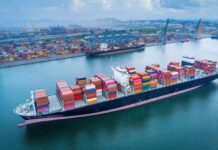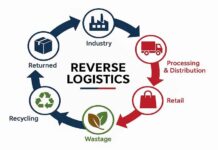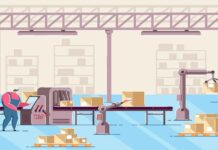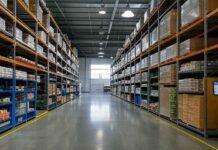Modern commerce, be it business-to-consumer or business-to-business, all depends on the accurate and timely as well as secure movement when it comes to goods, right from raw materials to finished products.
There is no shred of doubt that we are experiencing an ever-growing recognition when it comes to the vital as well as dynamic role that logistics play and the kind of tremendous contributor that they are to the global economy.
But the point is that along with great influence also comes great ownership and business opportunities. Besides this, it is also rewarding to witness the key role that industries, especially reverse logistics, go on to play when it comes to reducing waste streams, environmental stewardship, and energy conservation.
Although reverse logistics has been a pivotal and growing business model for quite some time now, the pandemic, due to its manifold supply chain challenges, brought about a completely novel understanding of the connections when it comes to commerce along with the potential bottlenecks. Innovative as well as exciting trends are indeed occurring, and their implications in terms of reverse logistics scenario cannot be overlooked be it e-commerce along with industrial sector.
E-commerce
There are an estimated 356 billion packages that were shipped across the world in 2023. The projections indicate that 498 billion packages are going to be shipped in 2028. A figure that is quite startling is that in 2022, the US parcels that were shipped per person numbered 64 packages, which is an increase of 73% from 2017.
Well, the fact is that these parcels to households can go on to contain almost anything, right from simple toys for the toddlers to high-end stereo systems, exercising equipment, digital cameras, etc. Notably, this activity has put forth enormous return activity too.
But all said and done, there has to be a better way – in comes reverse logistics.
There are many merchants who still relinquish the interest in merchandise once it is in the hands of the initial customer. But one continues to see greater desire to get the sellable material back to the warehouse shelf, specifically in the case of higher-value consumer goods.
The reverse logistics entity can go on to conduct a range of services, which include combinations of product inspection and repackaging as well as refurbishing, depending on the right condition as well as the client standards along with instructions. Reverse logistics operations can go ahead and determine if an item functions as per the way it should or might function properly with minimal repair or is not saleable at all.
Likewise, there are some items that can be restocked as they need a bare minimum polish or just repackaging. All these assignments can develop by way of an existing distribution relationship, in which the outbound distributor goes on to create a value service for the client. In totality, one can estimate that across all the merchandise types, almost 80% of the returned goods can be made fully fit, and they can enter a retail resale again.
The resulting benefit for the reverse logistics customer is less write-off when it comes to unsaleable merchandise and the capacity to restock wholesale distributors at a much lower cost and even in a quicker manner. It is well to be noted that for consumer products, refurbishing or repacking is becoming much more widespread and prevalent for high-cost items. But with time, one can expect this reverse supply loop to become more prevalent throughout a broader range of goods.
The industrial sector
There are some principles that can apply in numerous industry sectors, such as automotive, due to its complex supply chain of tiered supplies, many of which, as a matter of fact, go on to further serve each other.
Interestingly, automobiles happen to be one of the most complex mass-produced products across the world, and this web of relationships goes on to create ample opportunities for legitimate reverse logistics. For instance, there would be certain forgings as well as castings, which could be used in automotive sectors and can be pretty heavy. They could be sourced to the United States from overseas locations such as India. Due to the weight as well as bulk along with the value of these forged or cast parts, it goes on to become an attractive proposition to look into the refurbished and rejected parts in the United States. We all know time is money in the just-in-time manufacturing world, not to mention the shipping cost as far as the heavier parts are concerned, especially when airfreight goes on to get involved.
These kinds of services can range anywhere from small cosmetic issues, which are similar to what we often go to see with the consumer products, to even flaws across castings and forgings that may need additional machining.
Every reverse logistics scenario can go into determining its own comfort level and the degree of intricacy of its services in this chain. In some of the cases in which heavier machinery may be needed, it may make sense to retain skilled trade specialists on an ad hoc basis for such kinds of assignments.
In today’s world, there is indeed a wide range of reverse logistics specialists who are going to invest in operational equipment as well as testing and also skilled labor, which will be needed so as to repair technical parts of any type.
The value proposition
All the logistics assignments happen to involve the objective of achieving mutually beneficial relationships when it comes to sharing economic advantage and trust. But there is something that is taking place with the type of reverse logistics scenario which has been discussed. The fact is that we are not simply storing or rotating something. Due to inspection, cosmetic remedy, repair, and even repackaging functions, the reverse logistics entity happens to be taking the responsibility and becoming an active agent when it comes to maintaining a brand identity and integrity. Besides this, as with the automotive supplier example who is selling into the United States from overseas, the reverse logistics entity goes on to become a full-fledged manufacturer’s representative.
Hence, in a way it is clear how reverse logistics can grow out of the present logistics relationships and attain more intricate as well as more profitable business collaboration. As economic growth along with other necessities grows, this indeed is an extremely fruitful patch as far as business expansion is concerned.

























